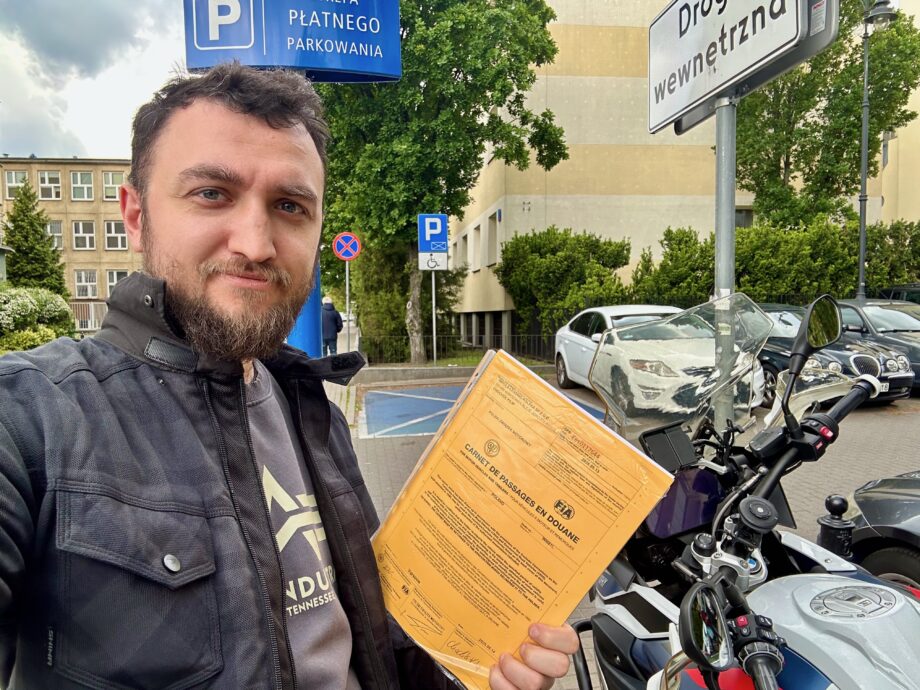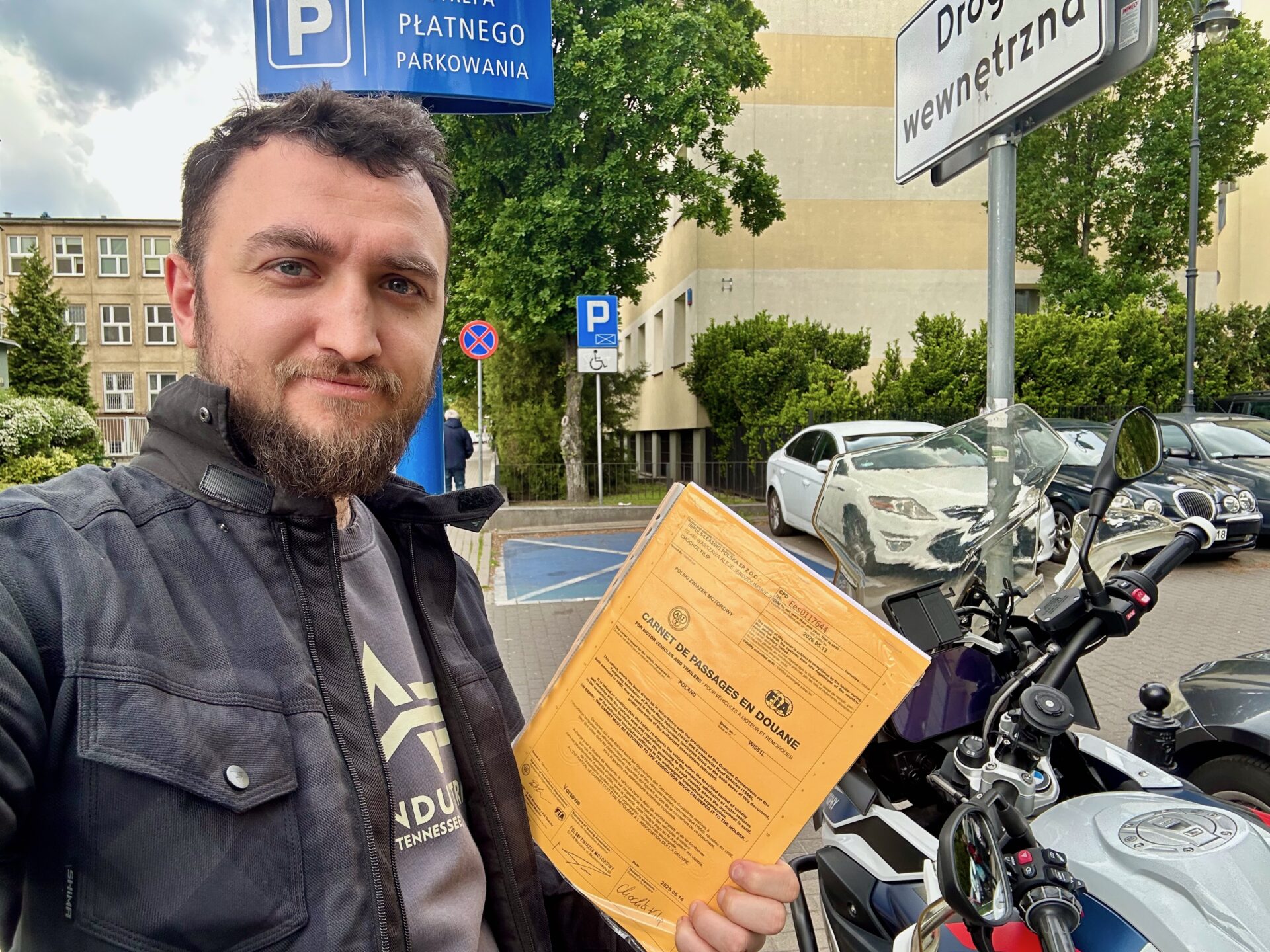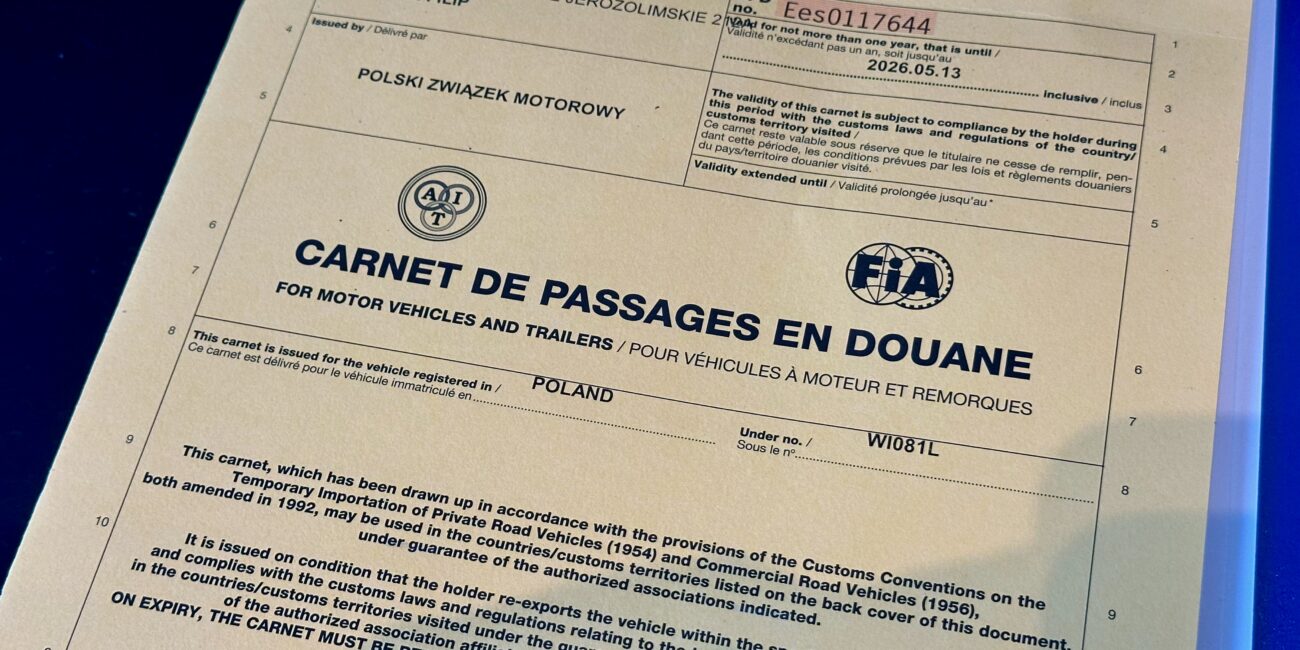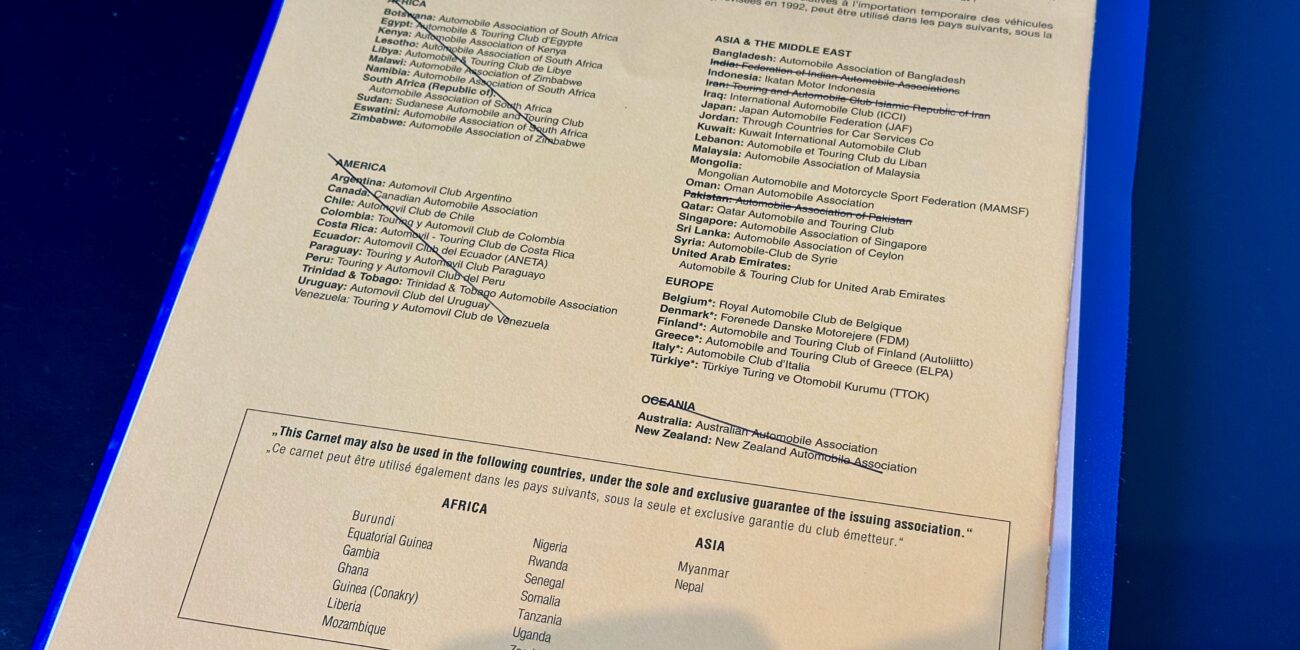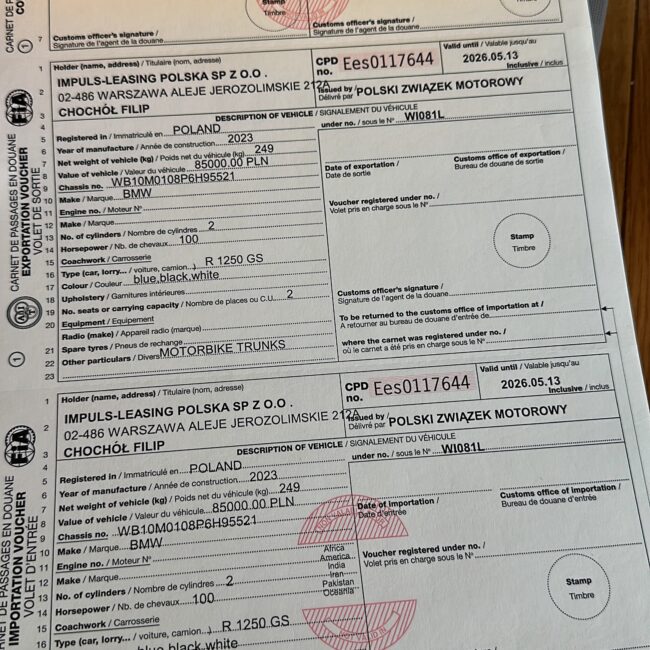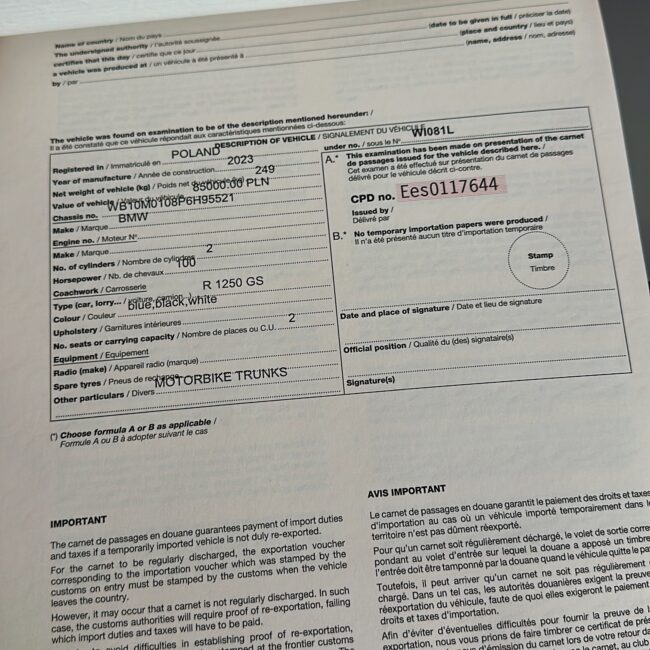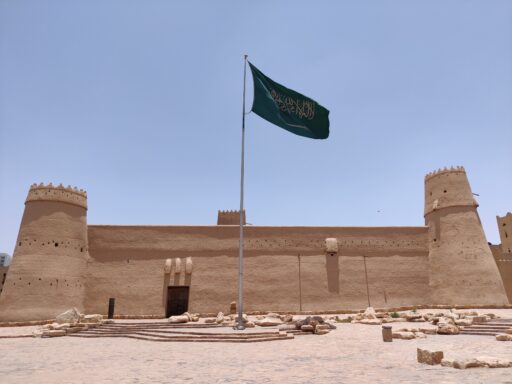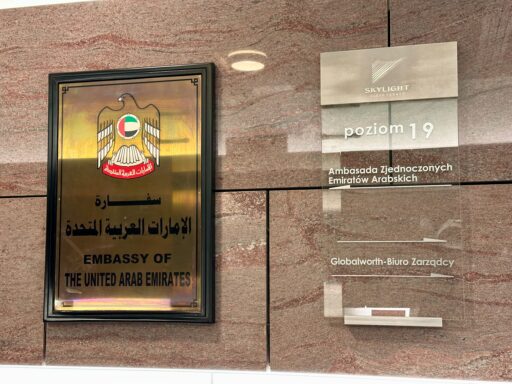This post is also available in:
Polski
Hello!
Riding a motorcycle around Europe is pretty straightforward — all you really need is a passport, insurance, and a full tank of fuel. But at some point, you start craving something more. Something that can’t be squeezed into a weekend trip. A journey where crossing a border isn’t just a formality, but a real process in itself.
That’s exactly why we decided to prepare for a trip beyond the European Union. But before we dive into the route, the places, and everything we’ll experience along the way – we need to start with the basics: paperwork. Because without the right documents, you won’t get much farther than the nearest Schengen checkpoint. And one of the key pieces of that puzzle is the Carnet de Passages – especially if, like us, your motorcycle is leased.
This post kicks off a series where we’ll walk you through the entire prep process, step by step. No fluff, no sugarcoating – just how it really works.
What is a Carnet de Passage?
The Carnet de Passages en Douane (CPD) is basically a passport for your vehicle. It allows you to temporarily enter many countries outside the European Union without having to pay import duties or taxes at the border. The document is issued for a specific car or motorcycle and serves as a guarantee that the vehicle will be taken back out of the country you’re entering.
In practice, the CPD works a bit like a guarantee. If you don’t leave the country with your vehicle, the organization that issued the document may be held responsible for paying the customs duties on your behalf. In our case, since we’re based in Poland, that organization is PZM (Polski Związek Motorowy). If you’re applying from another country, the equivalent would be your national automobile club.
That’s why a security deposit is required when applying for the CPD — sometimes quite a hefty one. It’s refunded after your trip, as long as you return the document properly stamped and complete.
The CPD isn’t required everywhere, but in many countries — especially in Asia, Africa, and the Middle East — you simply can’t enter with your own vehicle without it. So if you’re planning a trip beyond Europe, this is one of the first things you should look into.
Leased vehicle and Carnet de Passages
If your vehicle is leased, getting a Carnet de Passages becomes a bit more complicated — but it’s definitely still possible. It just involves a few extra steps and a bit more paperwork, since the vehicle isn’t technically yours. We’re describing the process for a motorcycle, but the same principle applies to cars, vans, or even trailers.
Is this even possible?
Yes, it’s definitely possible — but a lot depends on your leasing company’s internal policy. The key thing is what’s written in your contract. If there’s no mention of taking the vehicle outside the European Union… that’s actually a good thing. Seriously. That was the case for us — the absence of any restrictions on non-EU travel worked in our favor.
But the contract is one thing — the company’s attitude is another. And that’s where things can get tricky. A CPD isn’t something you can sort out with a quick email or a few clicks. For most leasing companies, this is an unusual request. They usually don’t have a ready-made process or template for it. Some will be helpful and sort it out without much hassle, while others might drag their feet or ignore you altogether. This isn’t like requesting a standard document to travel within Europe — it takes more persistence and patience.
Who owns the vehicle in the context of CPD?
With a leased vehicle, the legal owner is the leasing company — you’re just the user. And that’s exactly why you can’t apply for a Carnet de Passages on your own without their permission. The leasing company is technically the one “lending” you the vehicle for temporary use outside the country, and the CPD needs to reflect that.
So when submitting your documents to the Polish Automobile and Motorcycle Association (PZM), you’ll need to include not just your own details, but also the written permission from the vehicle’s owner. Without that, the CPD simply won’t be issued.
What needs to be done – step by step?
It’s a lot, we know — honestly, if you have the option to buy out your motorcycle, that’s probably the faster route. 😅 Leasing has its perks, but it definitely comes with a few extra hurdles. Anyway, back to the point…
Lessor’s consent
We totally get the appeal of leasing and the tax benefits that come with it — we’re taking advantage of that ourselves, so no judgment here. But if you’re planning to take your vehicle outside the European Union, the lease agreement alone just won’t cut it.
A lot of people mistakenly assume that a standard authorization to use the vehicle abroad — the kind you can download from your leasing company’s portal — is enough. Unfortunately, it’s not. When applying for a Carnet de Passages, you need a very specific document: a notarized authorization signed by at least two official representatives of the leasing company, as listed in the national business register (KRS in Poland). And this step is often the hardest part of the whole process.
In our case, the motorcycle (which we talk more about in a separate post) is leased through Impuls Leasing Polska. Even during the purchase stage, I mentioned to the sales rep that we were planning trips outside the EU and asked if the company had any objections. As you can probably guess — everything sounded great… right up until the moment we actually signed the contract.
In July 2024, I sent the first email requesting the necessary documents. And then… months of radio silence. Until April 2025, there were no real steps taken — just vague promises like “the board is open to it,” “we’re reviewing the matter,” or “you’ll get an answer soon.” But nothing ever actually happened. Even filing an official complaint didn’t help move things forward (though in theory, it could have been used later as part of a case with the Financial Ombudsman, had the company continued ignoring their legal obligation to respond).
So what actually worked? Calling them out publicly. I left a comment on a LinkedIn post from the company’s vice president — a post where they were proudly talking about their personalized approach to customer service. I explained our situation politely, without any hostility. I never got a reply, but the impact was immediate: the very next day, I was told that the company’s representatives had already scheduled a notary appointment. Two days later, the documents were ready for pickup. I later thanked the VP — if that outcome was thanks to her, then I genuinely appreciate it. But still… does it really have to come to this?
What documents should be prepared?
- A general authorization to use the vehicle abroad (in both Polish and English) — this one will be needed later for legalization, which we’ll cover at the end of the article.
- A separate, more detailed authorization outlining the lessee’s responsibilities related to the CPD. This document must list the specific countries you plan to travel through — you can’t just write “worldwide”.
The content of the second document must include mandatory provisions, such as:
Terms of authority and responsibility
- The authorization remains valid for the entire term of the lease agreement.
- The lessee shall bear full legal and financial responsibility for the vehicle during its use outside Poland, including:
- Insurance,
- Compliance with customs and traffic regulations,
- obligations arising from customs clearance and Carnet de Passages (CPD)
- The lessee is fully responsible for the formalities of CPD – applying for its issuance, incurring costs and legal obligations arising from the use of the vehicle in the above-mentioned countries.
- If the lease agreement expires during the CPD, the lessee assumes full responsibility for the vehicle and its return to Poland.
We do not take responsibility for whether the content described here will be accepted in your specific case. Every leasing company has its own internal procedures, and PZM may also have additional requirements depending on the situation. We’re simply sharing how it worked in our case and what kind of document was ultimately submitted to PZM Travel.
Application to Automotive club
You can find the application form on the official website of PZM Travel, in the section dedicated to the Carnet de Passages. The form itself isn’t complicated, but gathering all the required attachments — especially for a leased vehicle — takes some attention and patience.
For a leased vehicle, submit:
- application (in two copies),
- A copy of the vehicle registration certificate,
- A copy of your passport and driver’s license,
- A copy of your current Automotive membership card (if you have one),
- A copy of the lessor’s current copy of the National Court Register (downloadable from the National Court Register),
- lessor’s consent – in the form of a document signed by the company’s representatives in the presence of a notary, which we wrote about earlier,
- three photos of the vehicle:
- Diagonally in front,
- Rear with a visible license plate,
- VIN number (preferably from the body),
- confirmation of payment of the guarantee deposit,
- confirmation of the document fee.
In the application itself, you need to indicate:
- all the countries through which you plan to travel – if you are going one way and back through the same country, just enter it once,
- vehicle owner data – that is, the leasing company’s data (name, address, tax ID, etc.),
- Details of the vehicle user – that is, the person who physically rides the motorcycle and requests the document (that is, you),
- Vehicle data – including equipment (enter everything that is attached and is not removable by design – trunks, crash bars, grips, additional lights, etc.),
- The value of the vehicle – preferably according to a national insurance quote,
- Contact to the vehicle user – phone number and e-mail,
- details for the return of the deposit – account number and details of the account owner to which the amount is to be returned upon return.
You can either deliver the application in person to the PZM Travel office or send it by courier. We chose to hand it in ourselves — a notarized document isn’t something we were comfortable trusting to a courier, especially considering the risk of it getting lost in transit.
If you have any questions, it’s definitely worth reaching out to Ms. Ewa Zakrzewska, who handles the issuance of CPDs.
Deposit payment – how to determine its amount?
Each Carnet de Passages must be secured by a guarantee deposit, paid by wire transfer to the account of PZM Travel. The amount of this deposit depends on two things:
- Value of the vehicle (in PLN),
- and the countries you plan to travel through.
In our case, we declared the value of the motorcycle as 85,000 PLN and planned our route only through countries in the “other” category — meaning no India, Iran, Pakistan, Egypt, Sri Lanka, or any countries in Southern Africa. For that combination and a motorcycle (category 1), the required deposit was 22,000 PLN.
You pay the deposit from your own account – the leasing company is no longer involved in the process.
What does the number of cards in the carnet mean?
When submitting the application, you choose the CPD variant: 5-page, 10-page, or 25-page. Each “page” covers one full transit through a country — including both entry and exit.
So if you’re planning to travel through 5 different countries, you’ll need 5 pages. And if you enter the same country again on your way back, you’ll need an additional page for that country.
In our case, a 10-page carnet was enough. But it’s definitely worth planning your route carefully. While it is possible to extend the carnet, you can’t afford to run out of pages mid-trip.
The full fee table is available on the PZM Travel website, and it’s best to check it directly at the source — the rates may change over time.
What does one card look like?
Each sheet consists of three pages (copies):
- Importation Voucher – stays at the customs office of the country you are entering.
- Exportation Voucher – stays in the office when leaving the country.
- Counterfoil – this is the part that returns with stamps to the Automotive club and serves as proof that the vehicle entered and left legally. It must be stamped twice – at entry and at exit.
That’s why it’s so important not to lose any pages and always keep an eye on the stamps – without them, there could be a problem with the return of the deposit.
Receiving the document
From the moment the complete application is submitted, the waiting time for the Carnet de Passages is usually between 2 and 4 weeks. In our case, it took exactly 4 weeks. Once the document was ready, we were notified by email by Ms. Ewa from PZM Travel.
At the office, all we had to do was show up with an ID. They double-checked our details, we signed the receipt — and that was it. A quick, straightforward chat, and just like that, one of the most time-consuming parts of the preparation was behind us.
We also learned that cases where a leasing company actually agrees to provide a notarized authorization for travel outside the EU are pretty rare. Which makes us even more aware that we managed to get through something that, for many, ends in a dead end.
Costs associated with issuing CPD
Organizing a Carnet de Passages isn’t just about time and paperwork — it also comes with real costs that need to be factored into your travel budget. And if your vehicle is leased, that list of expenses gets a bit longer.
How much does the Carnet de Passages cost?
The final cost consists of several elements:
- The fee for issuing the carnet depends on the number of pages and whether you’re a member of PZM. In our case (a 10-page carnet, without membership), the cost was 1,250 PLN (incl. VAT). If you’d like an invoice issued to your business, make sure to include your company details when submitting the CPD application.
- The security deposit depends on the value of the vehicle and the regions you plan to travel through.
- Optional courier fee — we picked up the carnet in person, but if you prefer to have it shipped, expect to add around 40 PLN to the cost.
Return of deposit
The security deposit paid when applying for the Carnet de Passages is refundable — but only if certain conditions are met.
After the trip, you need to return the original CPD to PZM Travel with all the customs stamps in place — each used page must show both entry and exit stamps for every country. This serves as proof that the vehicle actually left each country it entered.
Only after those entries are verified and approved by the central office (which forwards the data to the FIA — the international body responsible for CPDs), PZM will refund the deposit to the account you provided.
This process can take up to 14 days, so it’s a good idea to take care of the paperwork as soon as you return. In our case, we’ll share an update once the refund actually happens — but that’s the official procedure.
Legalization of documents
Legalization is a whole process on its own, and we’ll cover it in detail in upcoming posts — one for each country we’ll be passing through. But for now, it’s important to understand that the leasing company’s authorization and the CPD application are just the beginning.
If you’re planning to travel through countries outside the EU, you’ll need not only the document for PZM but also a separate authorization to use the vehicle — prepared in a language that’s understood by the authorities in the destination or transit countries (for example, English, Arabic, or Turkish, depending on your route).
In our case, the authorized representatives of the leasing company signed two separate documents in front of a notary:
- The first — a document outlining the responsibilities related to the CPD, which was submitted in its original form to PZM Travel,
- The second — a general authorization to use the vehicle outside the EU, which we continue to work with: it’s translated by a sworn translator and goes through the legalization process.
The original of this second document stays at home — we only use certified copies (official duplicates confirmed by a notary), which are then sent to:
- a sworn translator (if the document wasn’t originally prepared as a bilingual version),
- a notary’s office (to certify the signature),
the Ministry of Foreign Affairs to obtain an apostille, or to the embassy of the relevant country — depending on the specific requirements.
All of this takes time and proper planning, so it’s best to start early. In our case, the entire process began several months before the planned trip.
We’ll cover the details of translations, legalizations, costs, and practical tips in a separate post coming soon.

